I still remember the first night I set up a voice control speaker and felt a tiny thrill when the lights responded to my voice. That moment changed how I think about daily routines. Now I design my living spaces around devices that make mornings smoother and evenings safer.
I focus on trusted products that work together today — from google nest audio in the living room to Matter-compatible bulbs and thermostats that cut energy use. I pick gear that answers to both an app and voice control so tasks feel natural, not fiddly.
In this guide, I give a room-by-room roadmap and clear buying choices. You’ll see security, climate, lighting, speakers, and kitchen helpers I rely on, plus honest trade-offs between budget and pro options.
Key Takeaways
- I build a connected home using reliable smart home devices and simple setup steps.
- Room-by-room picks help you prioritize purchases that deliver real benefits.
- Choose products that support Matter and platforms like google nest for fewer headaches.
- Voice control and app access deliver hands-free convenience for daily life.
- Thermostats and bulbs can save energy; cameras and locks add peace of mind.
Why I’m Upgrading to a Connected Home Right Now
I’ve been upgrading my living space because practical automation has matured into something I actually use. I can control thermostats, lights, door locks, cameras, and appliances from one app, and that convenience matters every day.
Remote access using phone and smart schedules now work smoothly over my internet connection. Devices learn routines, automate tasks, and send alerts when I’m away. That gives me real peace of mind whether you’re home or you’re away.
The upside is clear: better security, fewer small chores, and useful features without a huge upfront cost. Average installs sit near $897, but many individual products cost under $100, so I can upgrade one room at a time.
I’m choosing wireless setups to start for easy installs, and I’ll consider hardwired upgrades during renovations for even more reliability.
- I prioritize compatibility and long-term support so the system keeps improving.
- I focus on safety and comfort first—entry control, front yard security, lighting, and climate.
- Good privacy practices and low-maintenance devices help me save time and trust the system.
What Is a Smart Home and How Does It Work?
A smart home links everyday gear into one system I can manage from a phone, tablet, or laptop. I control door locks, thermostats, lighting, cameras, TVs, and appliances from a single app. That central control lets me set schedules, triggers, and notifications that run whether ‘re I’m home or away.
Remote control and automation come from the internet and the Internet of Things. Devices share status and events so a motion sensor can cue video recording, turn on lights, or send an alert. I use scenes like “Goodnight” to lock doors, dim lights, and lower temperature in one tap.
Remote control, automation, and the internet of things
Many smart devices learn routines and adjust lighting or air settings to save energy while keeping comfort. Push notifications and automated responses make the system useful without constant fiddling.
Wireless vs. hardwired foundations for your setup
Wireless builds are quick and affordable but depend on strong Wi‑Fi and a robust network. Hardwired systems cost more and need infrastructure, yet they give rock-solid reliability and lower hacking risk—common in new construction.
I prioritize platforms that support Matter so I can add smart home devices without locking myself in.
- I secure accounts, update firmware, and limit device access for privacy.
- I plan Wi‑Fi coverage and hardwired links for camera and video-heavy zones.
Choosing a Control Hub and App: My Take on Google Home
I chose a single control app because it made everyday tasks faster and easier to manage. The Google Home app puts the things I use most at my fingertips and keeps routines predictable.
Favorites and routines keep my day flowing. I pin lights, thermostat, and door lock to Favorites for one‑tap access. I also set routines so devices trigger on schedule or when I arrive and leave.
Pin favorites, automate routines, and control from anywhere
With voice control via Google Assistant, I can call up a scene or adjust lights hands‑free. Remote control over the internet means I manage things while traveling.
Matter compatibility and Works with Google Home partners
The app supports google nest, Matter devices, and many Works with Google Home partners. That reduces app clutter and lets different brands play nice together.
Viewing video history and Nest camera events
I check Nest camera events and filter activity in one place. The activity view helps me spot patterns and refine automations.
“Favorites and activity history made managing cameras and routines fast and clear.”
| Feature | Why I Use It | Notes |
|---|---|---|
| Favorites | Quick access to frequent controls | Lights, thermostat, locks front and center |
| Routines | Automates daily tasks | Saves energy and time |
| Camera History | Review key events | Filters make review fast |
| Compatibility | Unifies many brands | Works with Matter and google nest |
Front Yard Security Essentials: Cameras, Doorbells, and More
I start my perimeter plan with clear, weather‑proof cameras that record useful video day and night. For reliable home security, I pick gear that captures faces and license plates and that works together without extra fuss.
Outdoor security cameras for clear, reliable video
I use an outdoor camera that doubles as a hub so it does two jobs at once. The Aqara Camera Hub G5 Pro gives high‑resolution, color night vision and AI motion detection, and it also acts as a Matter/Thread/Zigbee hub to simplify my setup.
Smart doorbells that protect packages and answer the door
The Arlo Video Doorbell (2nd Gen) streams HD/2K with a 180‑degree view. It supports wired or wireless installs, works with voice platforms, and helps me speak to visitors or check packages when I’m ‘re away.
Smart locks for convenient, secure entry
I add a lock that gives more options than a key. The Ultraloq U‑Bolt Pro Wi‑Fi accepts fingerprint, keypad, app, voice, and physical keys so I can grant access and verify door status from anywhere.
Pro monitoring vs. DIY security systems
For full coverage I consider ADT Command for professional monitoring and white‑glove service. For lower cost and no long contracts, DIY options like SimpliSafe let me self‑monitor and stay flexible.
“I aim for products that play well together—cameras cue lights and doorbells trigger recording so nothing works alone.”
- I choose field of view and low‑light performance to capture useful footage.
- I prefer devices with clear install options: wired or battery depending on the spot.
- I fine‑tune alerts to focus on people and packages, not trees in the wind.
Entryway Upgrades: Smart Locks, Smart Glass, and Access Control
The front door sets the tone for safety and convenience. I upgraded mine to combine reliable entry locks with privacy-on-demand glazing. These changes make daily routines faster and reduce small worries about who came and went.
Voice control, fingerprints, keypads, and app-based access
The Ultraloq U‑Bolt Pro Wi‑Fi is my go-to lock because it supports fingerprint, keypad, app, voice, and traditional keys. I use fingerprint for quick entry and temporary codes for guests or deliveries.
Auto-lock and door-status alerts give me peace of mind. I favor locks that log events so I can check who unlocked the door from my phone.
Privacy-on-demand with switchable smart glass
Feather River Doors Smart Glass lets me toggle between opaque and transparent with a button or voice command. It gives natural light by day and privacy at night without curtains.
“I tie the entry routine to the rest of the connected home so foyer lights come on when the door opens.”
- I match the lock and glass to my door hardware during setup to avoid fit issues.
- I check battery life, backup keys, and offline fail-safes for reliability during outages.
- I pick finishes that blend with my entryway so the upgrades look timeless.
| Upgrade | Key Benefit | What I Check |
|---|---|---|
| Ultraloq U‑Bolt Pro Wi‑Fi | Multiple access methods | Battery life, backup key, event logs |
| Feather River Smart Glass | Instant privacy and light control | Voice toggle, opacity speed, fit to frame |
| Access Codes | Temporary secure entry | Code expiry, usage logs, admin controls |
Living Room Comfort: Speakers, Displays, and Entertainment Controls
I make the living room the command center for music, calls, and movie nights. A few well-chosen devices lift everyday entertainment without clutter or fuss.
Speakers for sound and voice control: I pick a speaker for the assistant I prefer — Amazon Echo (4th Gen) for Alexa, Google Nest Audio for google nest routines, or Sonos for higher-fidelity listening. The nest mini is great for casual voice control and quick answers.
Large displays and video: A big Echo Show 15 or Nest Hub Max doubles as a family calendar, a video call screen, and a control panel for cameras and lighting.
Plugs, power strips, and automation: I use a TP‑Link Kasa smart plug to track energy and a Kasa HS300 strip for multiple outlets. Those products let me automate lamps and fans and link scenes so lights and bulbs dim when a movie starts.
Indoor cameras and pet cams: For security and pets I rely on Eufy S220 for crisp video and Furbo 360 for treat tossing and bark alerts when I’m using phone to check in.
“Tiny swaps—better speakers, a large display, and a couple of plugs—made my living room feel intentional and easy to use.”
Smart Lighting Ideas: Bulbs, Scenes, and Energy Savings
Good lighting turns rooms from merely usable into places I enjoy spending time in. I start with color bulbs that offer a wide palette and multiple white temperatures so each room can feel right for the moment.
Color bulbs and music effects: I use AiDot Linkind Matter bulbs for 16 million colors, music-synced modes, and Wi‑Fi plus Matter compatibility. For parties I enjoy the music-sync, but most days I keep effects off so lighting stays calm and consistent.
Schedules, scenes, and energy: I set sunrise/sunset rules and use scenes like “Focus” and “Relax” to change a room in one tap. Smart lights use less energy and last longer than incandescent bulbs, so these choices cut energy use over time.
Room-by-room tips I use
- I name lights and assign rooms so voice and app control feel natural: “Dim dining lights to 30 percent.”
- Bedrooms get warm, dim evening tones and gentle wake-up routines to help sleep and mornings.
- Kitchens and offices stay bright and cool for tasks, then shift warmer at dusk for comfort.
- I pair bulbs with motion sensors in hallways and closets to save energy and avoid always-on lights.
- Where guests use a switch, I add a smart switch or plug so automations survive a flipped toggle.
“I choose Matter-compatible devices first so my bulbs and platforms keep working together over time.”
Climate Control Done Right: Thermostats, Sensors, and AC
A well-tuned thermostat and a quiet AC make daily comfort effortless.
I pick climate gear that balances rooms, saves energy, and stays simple to use. That means choosing thermostats with remote sensors, easy schedules, and clear usage insights.
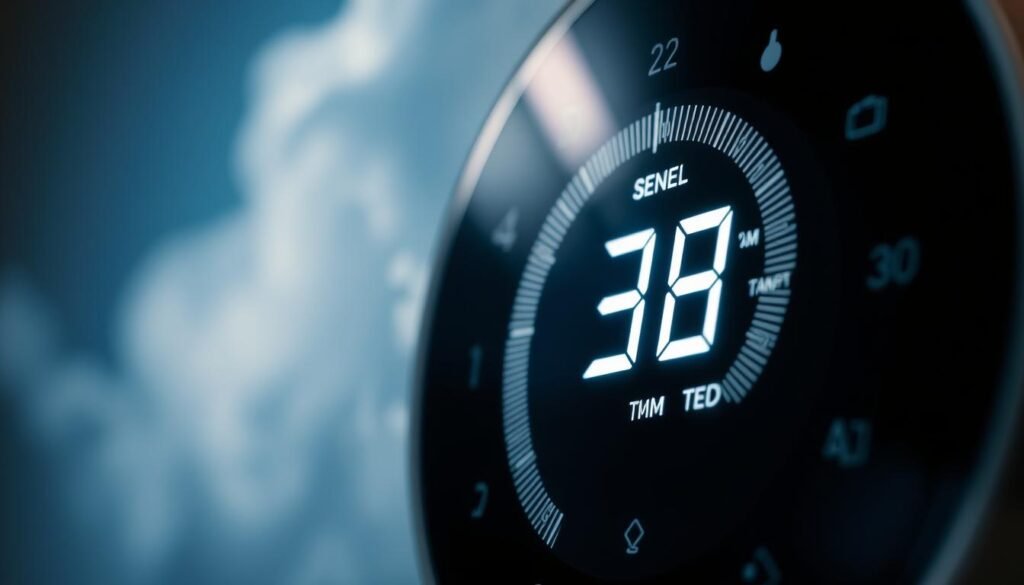
Thermostats with remote sensors and useful features
I use the Ecobee Smart Thermostat Premium for its included remote room sensor. It evens temperatures across bedrooms and living spaces and offers robust energy features and reports.
For tighter budgets, the Amazon Smart Thermostat covers essentials and pairs well with voice control and the app. Both let me pre-condition rooms and set vacation set-backs.
Quiet, efficient air options when central AC isn’t available
Where central cooling isn’t an option, I prefer a unit like the GE Profile Clearview Smart Air Conditioner. It keeps noisy parts low in the window line so the room stays quiet and the view stays clear.
“I schedule setbacks when I’m away and pre-condition before I return so comfort doesn’t cost more than it should.”
- I choose thermostats with remote sensors to avoid one-room bias.
- Energy-saving modes, learning schedules, and insights help me lower bills.
- I integrate climate with routines so the thermostat shifts when I lock up or arrive.
- I verify compatibility with google nest or my assistant so voice and app control stay responsive.
Building a Reliable Network for My Devices
A dependable network is the unsung backbone that keeps devices responsive and video smooth.
I treat my connectivity like critical infrastructure: without steady coverage, notifications lag, live view stutters, and routines falter. I prioritize predictable service so everyday controls feel instant and dependable.
Wi‑Fi coverage, extenders, and access points
I walk the house to find dead zones and place mesh nodes or extenders where signal drops. For larger properties I add hardwired access points so wireless lanes stay free for streaming.
I use Ethernet backhaul for high-traffic areas and 4K video to keep wireless congestion low. I also separate guest and IoT networks to keep device traffic organized and safer.
Why a solid network matters for cameras and video
Cameras, doorbells, and cloud video need steady bandwidth to record and upload. A weak link causes missed events and frozen live view when I need to check a feed.
I size my internet plan for peak usage and pick routers or mesh systems that get regular updates. WPA3, unique SSIDs, and strong passwords help keep my home security and security system safer.
“With a dependable network, my automations and controls feel instant across the entire house.”
- I plan outdoor device placement so cameras and doorbells have solid signal, not just indoor rooms.
- For reliability I choose gear that supports current standards and firmware updates.
- Organized credentials and periodic speed checks keep the setup healthy over time.
Kitchen Smart Picks: Cooking, Coffee, and Cleanup
A few well-chosen devices make weekday meals and weekend coffee routines easier to enjoy.
Countertop cooks and multi-mode ovens earn their place when they save time without fuss. I rely on the Tovala Smart Oven for no-hassle multi-stage cooking. The Instant Pot Pro Plus and Dreo ChefMaker Combi Fryer speed one-pot meals and crisp results when I’m short on time.
Coffee and morning rituals: Hamilton Beach’s coffee maker works with Alexa routines so a fresh pot waits on busy mornings. For barista-level brews I use xBloom Studio, which automates grind and pour for consistent results.
Fun extras and small conveniences: An Ecozy nugget ice maker keeps drinks party-ready. I pick products that support wi‑fi and integrate with the rest of my setup, not novelty-only features.
Cleaning helpers that earn their keep: For floors I recommend TP‑Link Tapo RV30 Max Plus if you need a budget self-emptying base. The Deebot X8 Pro Omni is a premium all-in-one. With pets, the Roomba j9+ dodges messes and Braava Jet m6 handles dedicated mopping.
- I keep an Echo Show 8 on the counter to follow recipes, set timers, and play entertainment while I cook.
- A Simplehuman Sensor Can keeps counters tidy and responds to voice so I never juggle trash with wet hands.
- I choose appliances that fit my routine, offer real features, and save me time every day.
“Countertop gear should earn its space—reliability beats gimmicks.”
Cleaning Powerhouses: Robot Vacuums, Mops, and All-in-Ones
Robot cleaners are the weekly chore I hand off so I can spend time on better things.
Self-emptying bases save me real time. I prefer vacuums that empty themselves so I only check the bin once in a while. The TP‑Link Tapo RV30 Max Plus delivers solid maps and a self-emptying dustbin for under $300, which makes it an excellent value appliance.
Advanced navigation matters. Accurate maps keep bots from bumping into furniture and make zone cleaning reliable. I set no-go lines for cables, pet bowls, and delicate rugs so the vacuum avoids trouble.
Pet-friendly picks and dedicated mops
For pet owners, the iRobot Roomba j9+ is a standout thanks to its POOP guarantee that avoids solid pet waste and reduces messy surprises. For deep hard-floor care I add a dedicated mop like the iRobot Braava Jet m6.
All-in-one units like the Ecovacs Deebot X8 Pro Omni are tempting: they empty dust, refresh the mop, and include a built-in voice assistant. That level of automation gives true set-and-forget convenience when it works well.
- I choose products with easy-to-find replacement parts to keep long-term costs predictable.
- Scheduling runs around my day—vacuum when I leave, mop later—keeps floors presentable without micromanaging robots.
- Zones and no-go lines keep cleaners away from trouble spots so reliability stays high.
“With the right combo, I reclaim time every week and maintain consistently tidy floors without micromanaging my robots.”
Bedroom Tech for Better Sleep and Air
A restful night starts with temperature control, clean air, and lighting that cues my body to unwind. I focus on gear that works quietly so the room feels like a retreat, not a lab.
Smart beds and temperature-controlled toppers
I tune comfort with the Sleep Number 360 i8 so each side of the mattress matches how I like to sleep. The Eight Sleep Pod Pro Cover adds active cooling and heating while tracking sleep stages so I can spot trends over time.
Air purifiers with HEPA and app control
Cleaner air helps me breathe easier each night. I rely on the Dyson Big+Quiet Formaldehyde BP03 for HEPA-grade filtration and quiet circulation. It reduces particles without ruining bedtime silence.
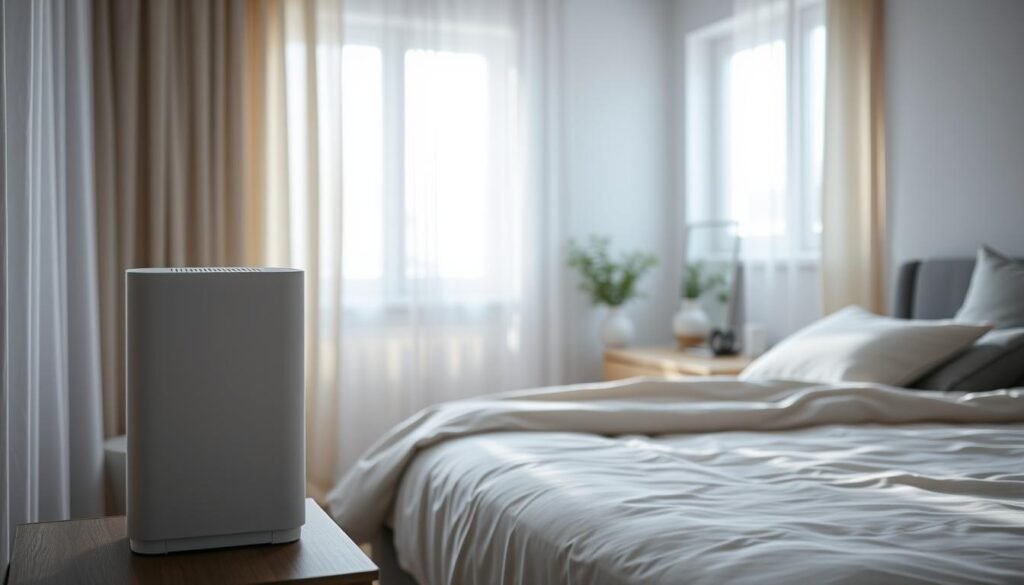
Relaxing bedside lighting and gentle wake-ups
I set a Philips Hue Iris lamp to warm, dim tones in the evening and a slow sunrise routine in the morning. For focus, a directed task lamp gives crisp light for reading without disturbing the rest of the room.
- I automate a wind-down scene—lighting, mattress temp, and white noise—to save time and stay consistent.
- GE Profile Clearview keeps cooling quiet and the view clear so AC doesn’t feel intrusive at night.
- Voice control helps me turn off lights and lock doors without getting out of bed when I’m already settled.
“With the right setup, my bedroom becomes a restorative space that adapts to my sleep schedule.”
Pet-Friendly Smart Home: Cameras, Treats, and Notifications
When I leave the house, a rotating camera and timely alerts let me know if my pet is okay.
Two-way audio and bark/meow alerts when I’m away
I keep an eye on my pet with cameras that offer two-way audio, so I can talk and listen in real time. The Furbo 360 Dog Camera sends barking notifications, rotates for a full view, and lets me toss treats while I’m using phone to check in.
The Furbo 360 Cat Camera adapts sounds for cats and adds a feather toy for play. For crisp, affordable video and tracking I use the Eufy S220 Indoor Cam.
“Bark and meow notifications helped me tell play from stress whether ‘re away.”
- I position cameras to cover favorite spots and food areas while respecting people zones.
- I fine-tune notifications so I only get alerts that matter, not every motion.
- I tie pet cams into routines—lights and gentle white noise calm anxious pets when I’m ‘re away.
| Model | Key Feature | Best For |
|---|---|---|
| Furbo 360 Dog Camera | Bark alerts, 360° view, treat tossing | Dogs and interactive check-ins |
| Furbo 360 Cat Camera | Cat sounds, feather toy, tailored alerts | Curious cats and playtime |
| Eufy S220 Indoor Cam | High-res video with tracking | Clear video at a budget-friendly price |
With pet cams and thoughtful notifications, I get peace of mind and my pets get attention even when I’m not there.
smart home
I start with simple tools that show clear benefits quickly, then expand from there.
Think room by room. I view a smart home as everyday conveniences you add without tearing anything out. A compact Google Nest Mini makes a great first device for voice and routine control, and it often costs under $50.
I build around what I already own. Bulbs, plugs, and a thermostat give visible wins fast. I focus on reliability and ecosystem support so additions keep working together.
- I try one platform first, then add proven devices that match it.
- I watch deals—many essentials dip under $100 so upgrades stay affordable.
- I add one or two home devices per month so the system grows naturally.
- I make sure each device solves a real problem: save time, boost comfort, or increase peace of mind.
“With a thoughtful approach, the system becomes a practical, personalized upgrade—not a gadget collection.”
Tip: Use your assistant and simple automations to stitch devices into routines that feel seamless. Start small, stay deliberate, and you’ll see real value before long.
Getting Started on Any Budget in the United States
A few affordable devices delivered the biggest day-to-day improvements for the least cost.
Under-$100 picks make real upgrades easy. A google nest mini is around $49 and adds voice, routines, and hands-free help the same day you unbox it. A reliable amazon smart plug or other smart plug often runs $10–$30 and automates lamps and small appliances without replacing anything.
Entry thermostats like Wyze or the Amazon Smart Thermostat can sit near or under $100 and cut energy use. Entry doorbells and refurbished Ring models sometimes appear at low prices and add package alerts and visitor video without a large install bill.
Room-by-room approach vs. whole-house automation
I recommend tackling one room at a time—living room, bedroom, or entry—so I learn the setup and avoid overspending. If I like the results, I expand into more rooms instead of committing to whole-home automation up front.
- I watch bundles and seasonal sales to stretch my budget.
- I pick devices that don’t need a hub unless I’m ready for that complexity.
- I prioritize upgrades that give back time and reduce friction when using phone or voice.
“Start small, test what saves you time, and grow your system when it makes sense.”
Privacy, Security, and Best Practices I Follow
Keeping my system safe feels as important as picking the right devices. I treat security as an ongoing habit, not a one-time setup. Small steps stop most threats and let my gear work reliably whether ‘re I’m home or away.
Strong passwords, updates, and trusted devices only
I use unique, strong passwords and a password manager so logins aren’t reused. I enable multi-factor authentication wherever it’s offered.
I keep firmware and apps updated to get patches quickly. I connect only trusted devices and disable unused services and ports to reduce risk.
I separate IoT gear on a distinct network and change default credentials immediately. I review privacy settings and prefer local storage when it fits my needs.
When to choose hardwired systems for added security
Hardwired systems are pricier, but they are more reliable and harder to hack. For new builds or major remodels, I plan wired runs for cameras and key sensors.
Wireless installs are affordable and fast, but they depend on a solid internet and network. I plan battery backups, local chimes, and offline controls so critical devices stay useful during outages.
“Fine-tuning notifications lets me know about motion, door events, and emergencies without drowning in noise.”
| Practice | Why I Do It | Quick Tip |
|---|---|---|
| Unique passwords + MFA | Reduces account takeover risk | Use a reputable password manager |
| Separate IoT network | Limits cross-device attacks | Guest SSID for visitors |
| Firmware & app updates | Closes known vulnerabilities | Enable auto-updates when possible |
| Hardwired runs | Boosts reliability and resilience | Plan during construction or remodels |
- I audit device access so family members only have needed controls.
- I fine-tune notifications to focus on important events and reduce false alarms.
- I regularly review sharing and revoke old codes or users to keep access current.
Conclusion
Conclusion
I wrapped up a practical path to a connected life that helps with everyday tasks and long-term goals.
Start small, with a speaker, a plug, or a bulb, then add thermostats, doorbells, and cameras as you see value.
Choose compatible products and devices so routines, video feeds, and energy-saving settings work together at each level.
Lean on a single app like google nest to manage history and automations, and keep security strong with unique passwords and updates.
Whether ‘re you upgrade one room or scale a whole system, the aim is simple: make tech fade into the background and let life run smoother.
FAQ
What does “connected home” mean and how does it work?
I mean a setup where devices—like cameras, lights, speakers, and thermostats—talk to each other and to my phone over the internet. I use apps or a central hub (for example Google Home) to control routines, check video feeds, and get notifications. Communication can use Wi‑Fi, Bluetooth, Zigbee, or Thread depending on the device and hub.
Do I need a hub or can I control devices with just my phone?
I often control basic plugs, bulbs, and cameras directly from their apps, but a hub (like Google Home or a Matter‑compatible controller) makes automations, voice control, and cross-brand routines more reliable. A hub also improves device discovery and lets me view Nest camera events and video history in one place.
How do wireless systems compare with hardwired installations?
I find wireless installs are cheaper and easier to expand, while hardwired setups offer higher reliability and better security for entry systems or whole‑home integrations. For critical devices like door locks or pro alarm panels, I prefer hardwired or professionally monitored options.
Which outdoor camera features should I prioritize for front yard security?
I look for clear 1080p or 2K video, good night vision, weather resistance, motion zones, and package detection on doorbells. Two‑way audio, reliable notifications when I’m away, and an easy way to review events in the app help me respond faster to deliveries or visitors.
Are smart doorbells worth it for package protection?
Yes. A doorbell with motion alerts and live view helped me stop porch theft once. Choose one with good video, clear audio, and cloud or local recording options so I can keep evidence if needed.
What’s the best way to secure my entry with smart locks?
I combine app access, temporary codes for guests, and a keypad or fingerprint option for convenience. I also enable two‑factor authentication on accounts and keep firmware updated to reduce risk. For high security, I consider professionally installed locks that support hardwired backup.
Should I choose pro monitoring or DIY security?
I prefer DIY if I want lower recurring costs and full control. Pro monitoring gives faster emergency dispatch and can be useful if I travel a lot or want 24/7 oversight. It comes down to budget and how much responsibility I want for managing alerts.
How do I integrate speakers and displays for better living room control?
I connect voice assistants like Google Nest Mini and smart displays to control media, call family, and show camera feeds. Grouping speakers gives consistent audio across rooms, and smart plugs let me automate non‑connected devices like lamps or older TVs.
Can I run robot vacuums and smart plugs together to automate cleaning?
Absolutely. I schedule vacuums and use smart plugs to power devices on a routine—like turning off a humidifier during vacuuming. Automation reduces friction and keeps routines consistent without manual intervention.
How do lighting scenes and color bulbs improve energy use?
I use schedules and scenes to dim or turn off lights when rooms are unused, which cuts wasted energy. Color bulbs add ambiance for activities and can sync with music for entertainment, while timers handle day‑to‑day savings.
What should I know about thermostats and air conditioners with app control?
I pick thermostats with remote sensors and energy reports to reduce bills. For AC, look for quiet operation and smart scheduling. Integration with occupancy sensors or geofencing improves efficiency by cooling only when needed.
How important is my Wi‑Fi network for cameras and video performance?
A strong network is critical. I use extenders or access points to eliminate dead zones and prioritize bandwidth for cameras. A reliable connection reduces dropped feeds and ensures timely notifications and smooth video playback.
Which kitchen devices are worth upgrading first on a budget?
I start with a connected coffee maker for morning routines, a countertop oven or air fryer for faster meals, and a robot vacuum for daily cleanup. Smart plugs and a display on the counter add hands‑free convenience without a big investment.
When does a robot mop make more sense than a vacuum alone?
If I have hard floors with frequent spills or pet messes, a dedicated robot mop handles stains better than a vacuum. Models with mapping and nozzle control avoid over‑wetting and do a more thorough job.
What bedroom tech actually improves sleep and air quality?
I use temperature‑controlled mattress toppers or smart beds to maintain comfort, and HEPA air purifiers with app control to reduce allergens. Gentle wake lights and low‑blue bedtime scenes on bulbs help me fall asleep more naturally.
How do I set up pet‑friendly monitoring and alerts?
I use indoor cameras with two‑way audio and pet activity alerts to check on my dog. Treat dispensers and designated pet cams help with separation anxiety, and bark/meow notifications tell me when I need to check in.
Where should I start if I’m building this setup on a small budget?
I begin room‑by‑room. Pick an under‑0 speaker or smart plug, a basic doorbell for entry security, and one thermostat or camera for a high‑use area. Expanding gradually lets me refine routines and manage costs.
What privacy and security practices do I follow with connected devices?
I use strong, unique passwords, enable two‑factor authentication, keep firmware updated, and only add devices from trusted brands. I also segment devices on a guest network when possible and prefer local storage or reputable cloud services for sensitive video.
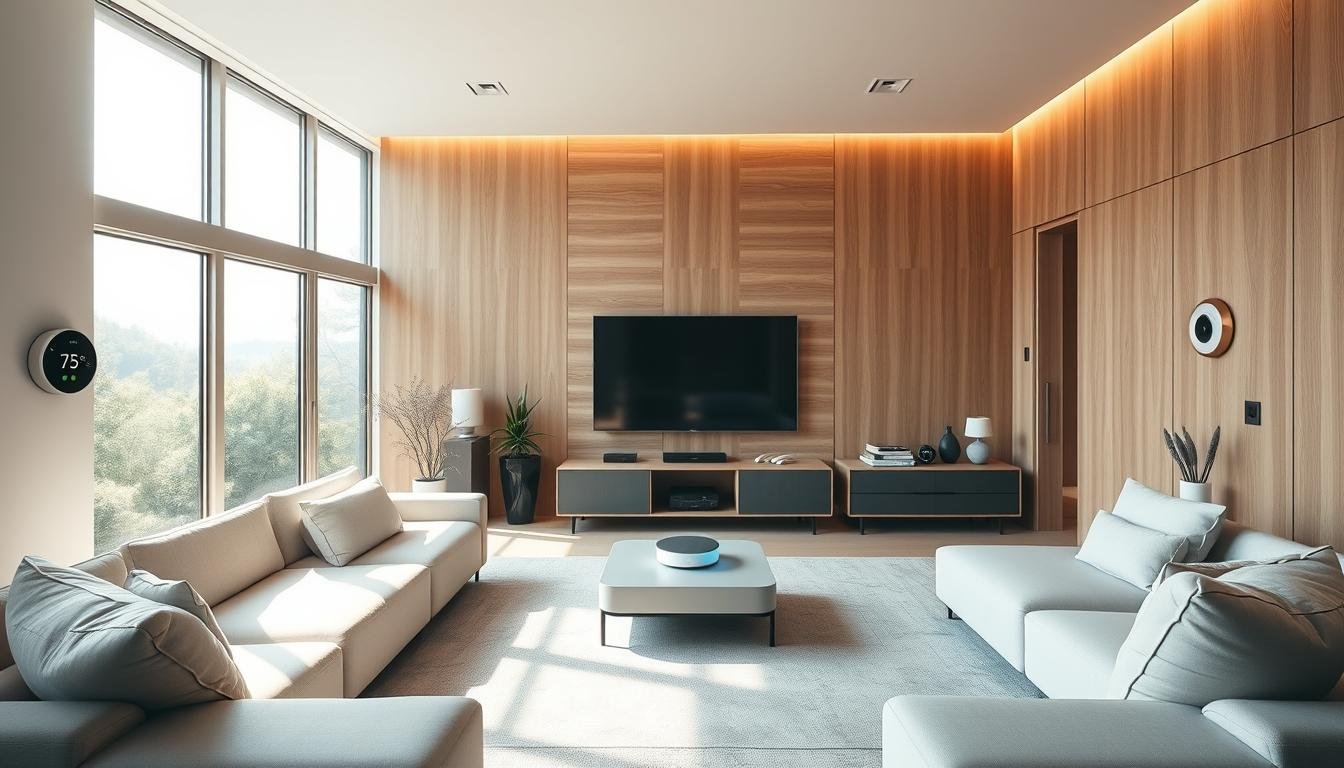




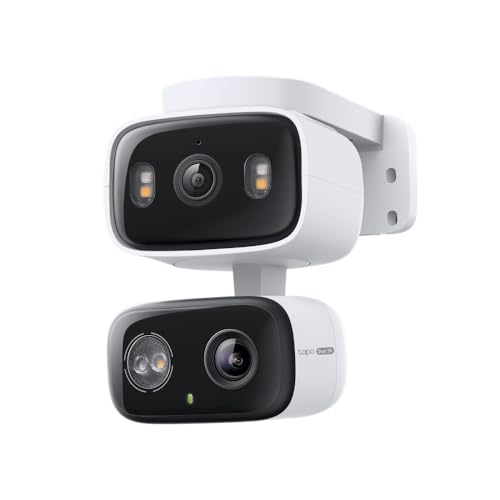









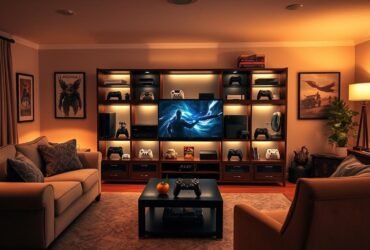
Leave a Reply